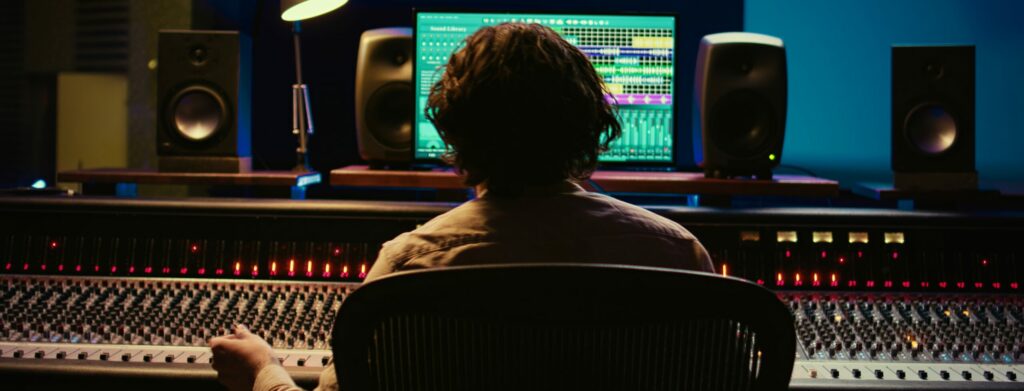Film Mastering is an intricate process that goes beyond simply balancing audio levels. Mastering for Film, TV, or Video involves a deep understanding of sound design, dialogue clarity, and the various audio formats that are essential in the film and television industry. The importance of mastering cannot be overstated, as it ensures that the final audio product meets industry standards and provides an optimal listening experience for the audience. In this article, we will explore the nuances of mastering specifically tailored for film and television, highlighting the key differences from music mastering and providing techniques that audio engineers can utilize to deliver high-quality soundtracks.
Table of Contents
- What is Mastering?
- Understanding Film Mastering
- Film Mastering Techniques and Tools
- Important Considerations when Film Mastering
- Analyzing Successful Film Soundtracks
- Common Mistakes in Film Mastering
- Conclusion
What is Mastering?
Audio Mastering is the process of preparing and transferring recorded audio from a source to a data storage device, ensuring that it is ready for distribution. The purpose of mastering in audio production is to enhance the overall sound quality and ensure that the audio is consistent across all playback systems. In the context of film and TV, mastering is not just about making the audio sound good; it is about making it sound right for the specific medium. This involves adjusting levels, EQ, audio compression, and other effects to create a polished final product that meets industry standards.

Understanding Film Mastering
Film Mastering is a specialized process that requires an understanding of how sound interacts with visuals. This section will delve into the foundational aspects of mastering for film, explaining its role in the audio production pipeline. Mastering is the final step before audio is delivered for distribution, and it involves preparing and transferring recorded audio from a source to a data storage device. In film and television, the mastering process is crucial as it not only enhances the overall sound quality but also ensures that the audio aligns seamlessly with the visual elements. Key aspects to consider in mastering for film and TV include:
- Sound Design: Crafting a unique auditory experience that complements the visuals.
- Dialogue Clarity: Ensuring that spoken words are intelligible and clear, which is paramount in storytelling.
- Audio Formats: Understanding the different formats (like Dolby Atmos, stereo, etc.) and their implications on sound quality.
The mastering engineer must be adept at using various tools and techniques to achieve the desired sound, taking into account the unique requirements of each project, especially when it comes to mastering audio for film.
Differences Between Music and Film Mastering
While both music and film mastering share the goal of producing high-quality audio, there are significant differences in their approaches. Music mastering focuses primarily on the musical elements, such as rhythm, melody, and harmony, while mastering for film requires a greater emphasis on dialogue clarity and sound design. Some key differences include:
- Dialogue Importance: In film, dialogue must be clear and intelligible, often requiring specific adjustments to ensure it stands out amidst background sounds.
- Sound Design Integration: Film mastering involves integrating sound effects and music in a way that complements the visuals, which is less of a concern in music mastering.
- Dynamic Range: Films often require a broader dynamic range to accommodate quiet dialogue and loud action sequences, whereas music may be more uniform in its dynamics.
Understanding these differences is crucial for mastering engineers working in the film and television industry.
Focus on Dialogue and Sound Design
When mastering audio for film, the emphasis on dialogue clarity and sound design cannot be overstated. Dialogue is the primary means of storytelling, and it must be clear and easily understood by the audience. This often requires careful attention to levels, EQ adjustments, and the use of tools like de-essers to reduce sibilance.
Additionally, sound design plays a critical role in enhancing the emotional impact of a scene. This involves creating or manipulating sound effects that complement the visuals, helping to build tension, excitement, or drama. Effective sound design can elevate a film from good to great, making it an essential aspect of the mastering process.
Audio Formats and Their Implications
Different audio formats have unique characteristics that can greatly affect the mastering process for film and TV. Common formats used in film and TV include stereo, 5.1 surround sound, and Dolby Atmos. Each format has its own set of requirements and challenges that mastering engineers must navigate. For instance:
- Stereo: The simplest format, often used for television broadcasts and online streaming. It requires careful panning and balancing of audio elements.
- 5.1 Surround Sound: This format adds depth by using multiple channels, allowing for a more immersive experience. Mastering for this format requires precise placement of sounds in the spatial field.
- Dolby Atmos: This advanced format allows for object-based audio, meaning sound can be placed and moved in three-dimensional space. Mastering for Dolby Atmos requires specialized tools and techniques.
Understanding these formats is essential for mastering engineers to ensure the final product sounds great on any playback system.

Film Mastering Techniques and Tools
There are several mastering techniques and tools that are vital for achieving high-quality audio in film and television. This section will explore various methods that mastering engineers can employ to enhance the audio experience.
Equalization Techniques
Equalization in Mastering is a fundamental tool, allowing engineers to adjust the frequency balance of audio tracks. In film and TV, EQ is used to achieve clarity and ensure that dialogue cuts through the mix without being harsh or overwhelming. Key EQ techniques include:
- High-Pass Filtering: Removing low-frequency rumble that can muddy the mix.
- Presence Boosting: Enhancing mid-range frequencies to make dialogue more intelligible.
- De-Essing: Reducing sibilance in vocal tracks to achieve a smoother sound.
By applying these techniques, mastering engineers can create a balanced and polished final product.
Dynamic Range Management
Dynamic range management is crucial for enhancing the listening experience in film and television. It involves controlling the difference between the softest and loudest parts of the audio, ensuring that dialogue is clear while still allowing for impactful sound effects. Techniques for managing dynamic range include:
- Compression: Reducing the dynamic range to ensure dialogue remains audible during loud scenes.
- Audio Limiting: Preventing audio peaks from distorting by setting a maximum output level.
- Mix Automation: Adjusting levels throughout the track to maintain balance and consistency.
These techniques help create a cohesive audio experience that engages the audience.
Loudness Standards in Film and TV
Loudness standards are essential in the film and television industry to ensure consistency across different platforms and playback systems. Understanding these standards is crucial for mastering engineers to deliver audio that meets industry expectations. Key loudness standards include:
- EBU R128: A European standard that sets guidelines for loudness levels in broadcasting.
- ATSC A/85: A standard used in the United States for television broadcasts.
- ITU-R BS.1770: A recommendation for measuring loudness and true-peak levels.
By adhering to these standards, mastering engineers can ensure that their audio is compliant and delivers a consistent experience for viewers.
Using Surround Sound and Stereo Techniques
Mastering with surround sound and stereo requires different approaches to create an immersive listening experience. Surround sound utilizes multiple channels to envelop the audience in audio, while stereo focuses on creating a balanced left and right channel mix. Some techniques include:
- Panning: Distributing sounds across the stereo field to create a sense of space.
- Depth Creation: Using reverb and delay to position sounds within the mix.
- Channel Balance: Ensuring that no single channel dominates the mix, providing a cohesive sound.
These techniques are essential for creating an engaging and immersive audio experience in film and television.
Important Considerations when Film Mastering
When mastering audio for film and television, there are several critical considerations that audio engineers must keep in mind. These considerations ensure that the final product meets industry standards and provides an optimal listening experience.
Collaboration with Directors and Sound Designers
Collaboration is key when mastering for film or TV, particularly with directors and sound designers. Effective communication ensures that the audio aligns with the creative vision of the project. Important aspects of collaboration include:
- Feedback Loops: Regular check-ins to discuss audio emphasis or intention in specific parts of the film to make necessary adjustments.
- Creative Input: Incorporating the director’s vision and the sound designer’s expertise into the film mastering process.
- Final Approval: Ensuring that all parties agree on the final product before distribution.
This collaborative approach helps create a cohesive audio experience that enhances the overall production.
Feedback and Revisions
The necessity of feedback loops and revisions in the mastering process cannot be overstated. Feedback from directors, producers, and sound designers is essential to refine the audio and achieve the desired outcome. Key points to consider include:
- Iterative Process: Mastering is often an iterative process that may require multiple revisions based on feedback.
- Listening Sessions: Conducting listening sessions with stakeholders to gather input and make adjustments.
- Final Touches: Implementing final tweaks based on feedback to ensure the audio meets expectations.
By embracing feedback and being open to revisions, mastering engineers can deliver a polished final product.

Analyzing Successful Film Soundtracks
Real-world examples can illustrate the concepts and techniques discussed in mastering for film and television. Analyzing successful film soundtracks provides insights into effective mastering practices. Case studies of successful film soundtracks reveal the techniques used in their mastering for film. These examples highlight the importance of dialogue clarity, sound design integration, and adherence to loudness standards.
For instance, a film renowned for its immersive sound design may utilize surround sound techniques to create an engaging experience while ensuring that dialogue remains clear and intelligible.
Common Mistakes in Film Mastering
Understanding common mastering mistakes made during the mastering process can help engineers avoid pitfalls. Some common issues include:
- Neglecting Dialogue Clarity: Failing to prioritize dialogue can lead to a confusing audio experience.
- Ignoring Loudness Standards: Not adhering to industry standards can result in audio that is too quiet or too loud.
- Overprocessing Audio: Applying too much compression or EQ can lead to a lifeless sound.
By being aware of these mistakes, mastering engineers can improve their practices and deliver higher-quality audio.
Conclusion
In conclusion, mastering for film and television is a multifaceted process that requires a deep understanding of sound design, dialogue clarity, and audio formats. By employing effective techniques and tools, mastering engineers can create high-quality soundtracks that enhance the viewing experience. Collaboration with directors and sound designers, along with careful attention to feedback and revisions, is essential in achieving the final master. As the industry continues to evolve, staying informed about best practices and standards will ensure that audio professionals deliver exceptional audio experiences in film and television.
Informazioni sull'autore

Dídac
CEO e fondatore di MasteringBOXDídac è un ingegnere audio professionista, produttore musicale e ingegnere software. È il fondatore di MasteringBOX e l'autore di molti degli articoli del blog.
Lascia un commento
Log in per commentare


